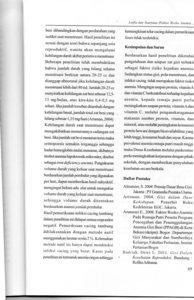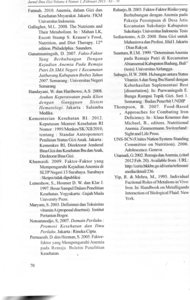Lutfia, lutfia and Suarjana, I Made (2013) FAKTOR RISIKO ANEMIA BESI PADA REMAJA PUTRI DI KOTA DENPASAR. Jurnal Ilmu Gizi, 4 (1). pp. 63-70. ISSN 2087-183X
This is the latest version of this item.
![[img]](http://repository.poltekkes-denpasar.ac.id/5570/1.hassmallThumbnailVersion/img036.jpg)
|
Image
img036.jpg Download (1MB) | Preview |
|
![[img]](http://repository.poltekkes-denpasar.ac.id/5570/2.hassmallThumbnailVersion/img036.jpg)
|
Image
img036.jpg Download (1MB) | Preview |
|
![[img]](http://repository.poltekkes-denpasar.ac.id/5570/3.hassmallThumbnailVersion/img037.jpg)
|
Image
img037.jpg Download (1MB) | Preview |
|
![[img]](http://repository.poltekkes-denpasar.ac.id/5570/4.hassmallThumbnailVersion/img038.jpg)
|
Image
img038.jpg Download (1MB) | Preview |
|
![[img]](http://repository.poltekkes-denpasar.ac.id/5570/5.hassmallThumbnailVersion/img039.jpg)
|
Image
img039.jpg Download (1MB) | Preview |
|
![[img]](http://repository.poltekkes-denpasar.ac.id/5570/6.hassmallThumbnailVersion/img040.jpg)
|
Image
img040.jpg Download (1MB) | Preview |
|
![[img]](http://repository.poltekkes-denpasar.ac.id/5570/7.hassmallThumbnailVersion/img041.jpg)
|
Image
img041.jpg Download (1MB) | Preview |
|
![[img]](http://repository.poltekkes-denpasar.ac.id/5570/8.hassmallThumbnailVersion/img042.jpg)
|
Image
img042.jpg Download (1MB) | Preview |
|
![[img]](http://repository.poltekkes-denpasar.ac.id/5570/9.hassmallThumbnailVersion/img043.jpg)
|
Image
img043.jpg Download (2MB) | Preview |
|
![[img]](http://repository.poltekkes-denpasar.ac.id/5570/10.hassmallThumbnailVersion/img044.jpg)
|
Image
img044.jpg Download (1MB) | Preview |
|
![[img]](http://repository.poltekkes-denpasar.ac.id/5570/11.hassmallThumbnailVersion/img045.jpg)
|
Image
img045.jpg Download (1MB) | Preview |
Abstract
Female teenagers were at risk of having anemia. This was because at their age there was an increase in the demand for iron for growth and due to menstruation. Iron deficiency anemia, inthis case, might be caused by several factors such as knowledge, attitude, nutritional status, dietry intake (protein, vitamin A, vitamin C, Fe and calcium), menstrual patterns and hookworm infection. This study aimed to find the risk factors of iron deficiency anemia in female teenagers. The design used in this study was analytical (observational) with a case control approach. The subject of this study was 135 feemale teenagers which were then divided in 45 cases and 90 control group. Subjects in the control group was selected by simple random sampling. Results analyzed by bivariate tests showed that there was a relationship between anemia with knowledge on anemia (OR=4,1; 95 % CI= 1,934-8,799), protein intake (OR=6,2; 95 % CI= 2,802-13,522), vitamin A intake (OR=3,6; 95 % CI=1,452-8,987), vitamin C intake (OR=5,2; 95 % CI=2,401-11,260), dietry iron intake (OR=3,5; 1,594-7,831), amount of tampons used (OR=5,5; 95 % CI=2,188-13,645) and menstrual patterns (OR=2,6; 95 % CI=1,244-5,632). Whereas from logistic regression test with enter method it was found that the independent variables that influenced the incidence of iron deficiency anemia were knowledge on anemia (OR=10,1; 95 % CI=2,902-34,925), protein intake (OR=3,9; 95 % CI=1,135-13,867), vitamin A intake (OR=6,8; 95 % CI=1,626-28,261), vitamin C intake (OR=4,1; 95 % CI=1,309-13,134) and the amount of tampons used (OR=14,5; 95 % CI= 3,007-70,202). Among these variable the one that had the most influence was the amount of tampons used. This indicated that the those with excess volume of menstrual blood had a high risk of having iron deficiency anemia. Thus, it can be concluded from this study that the risk factors of anemia in female junior highschool students were: knowledge on anemia, dietry intake of: proteins, vitamin A, vitamin C and the amount of tampons used. The author reccomended the following effort to prevent iron deficiency anemia: widen the targets of intervention hrough schools and informal educations. This could be done by activating health services in high school students through routine hemoglobin level measurements with Sahli method in puskesmas and increasing the variety of foods consumed in an effort to increase dietry intake of protein, vitamin A and vitamin C. Keywords: iron deficiency anemia, risk factor, female teenagers
| Item Type: | Article |
|---|---|
| Subjects: | R Medicine > RA Public aspects of medicine > RA0421 Public health. Hygiene. Preventive Medicine |
| Divisions: | Jurusan Gizi |
| Depositing User: | Abdur Rahman |
| Date Deposited: | 27 Jul 2020 00:06 |
| Last Modified: | 27 Jul 2020 00:06 |
| URI: | http://repository.poltekkes-denpasar.ac.id/id/eprint/5570 |
Available Versions of this Item
-
FAKTOR RISIKO ANEMIA BESI PADA REMAJA PUTRI DI KOTA DENPASAR. (deposited UNSPECIFIED)
- FAKTOR RISIKO ANEMIA BESI PADA REMAJA PUTRI DI KOTA DENPASAR. (deposited 27 Jul 2020 00:06) [Currently Displayed]
Actions (login required)
 |
View Item |











